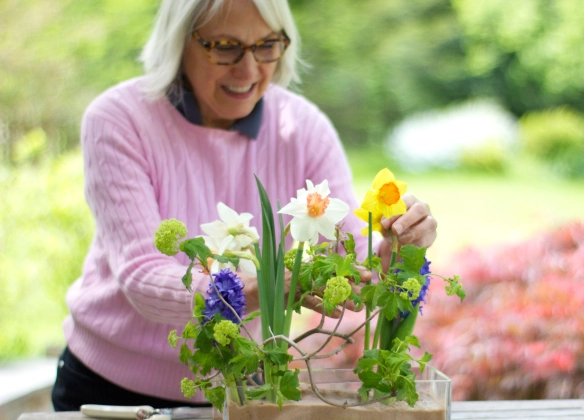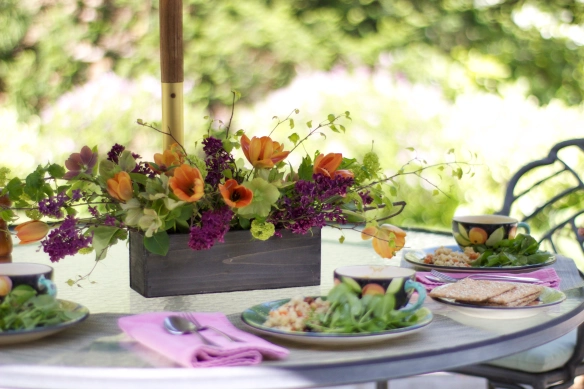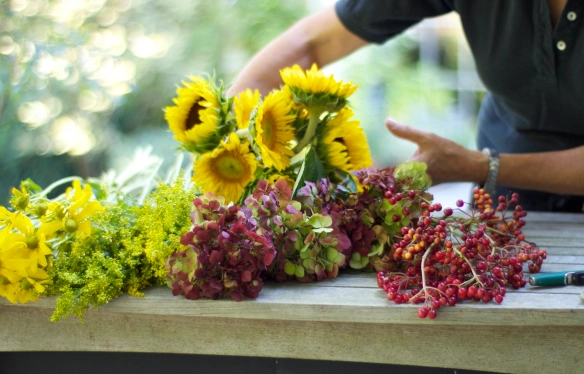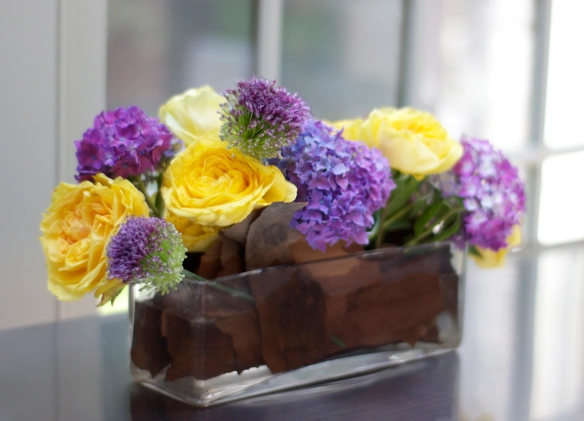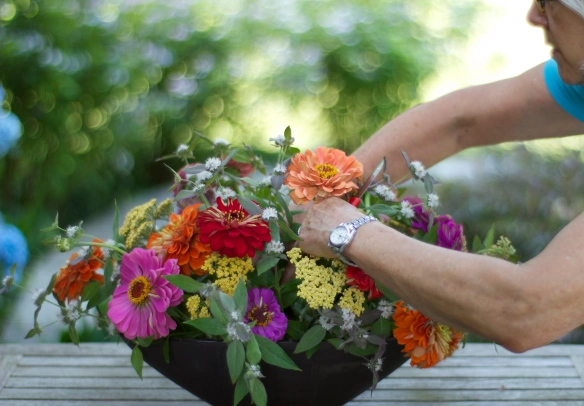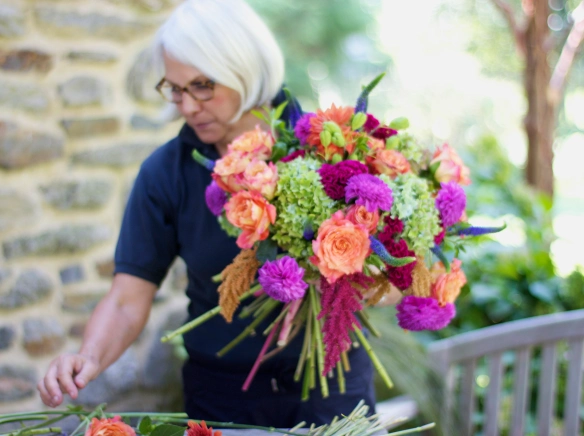I was eager for class #2, possibly because I felt a little more confident after the previous weeks of floral experience at the shop, and because it seemed we’d only scratched the surface during class #1. There’s so much to learn when you’re dealing with plants, and that’s part of the reason I like it. I never want to run out of new things to learn.

We are encouraged to make a little sketch before we begin, this is mine.
While waiting for the rest of the class to show, a few students and the teacher were discussing the upcoming Longwood lecture on Sustainable Floral Design. Someone wondered about the lecturer, Jane Clark, and because I had been researching this topic, and her, I piped up that she had once had a shop called Fleurish which was no longer in business. Our teacher’s immediate reply was, “that’s because you can’t do sustainable flowers. Is organic impossible? To be competitive, yes it is.” She went on to say that if you’re bidding against a non-sustainable florists, their prices are always going to be lower. Organic flowers cost much more. But..isn’t there a market (maybe small, yes) of people who want “green” flowers, who don’t want the flowers at their wedding flown in from Columbia, dripping with pesticide? This will be a big topic for me, I think, and I’m just starting to research how others approach it.

Locally grown arrangement created by Jennie Love, photo courtesy of lovenfreshflowers.com
Some just grow their own flowers and are done with it. You have to admire that approach, and that’s why someday I want to meet Jennie Love, proprietor of Love ‘n Fresh Flowers. She grows her own flowers in an urban location, which she sells through local stores and a Flower CSA, and also creates unique floral designs for events such as “eco-lovely weddings.” She’s doing a Floral Fun class at Longwood in the summer I hope to attend.

Arrangement in shape of Hogarth's Curve of Beauty
Ok, back to class. We discussed the Shape of floral arrangements. They can be round, horizontal, crescent, vertical, oval, symmetrical and asymmetrical triangle, fan, Hogarth (curve of beauty,) or parallel systems. Gosh, I hope I never have to make a Hogarth arrangement…too hard! We talked about Balance, Proportion and Scale within the context of these shapes, and then moved on to the flower and foliage forms.

Lily is example of a Form Flower - distinctive shape - this has been blooming for 2 wks
For example, line Flowers are linear in shape, and create height in an arrangement. Like Delphinium, Snapdragon, etc. Form flowers have distinctive shapes which add interest to a design: like Gerbera, Amaryllis, Lily. Mass flowers are solitary flowers with a single round head like Roses, Carnations. Filler flowers – Baby’s breath, Waxflower, Queen Anne’s Lace. And then the Renegade flower is one which may be used as more than one type or just doesn’t fit into any category, like Bird of Paradise.

Florida Ruscus is 'mass foliage' hiding the mechanics, baker fern is filler and adds a dainty edging
Similarly, foliage has its’ forms as well. Linear like spiral eucalyptus, flax, or some grasses. Form foliage has an interesting shape or texture, color or pattern, like papyrus, monstera leaves, caladium. Mass foliage adds bulk and covers the mechanics of an arrangement, like pittosporum, huckleberry, camellia, leatherleaf. Filler foliage is smaller in scale and sometimes wispy, like fern, boxwood, ivy.

After the greens, Jane adds stock flower - the "line flower" always goes first
For this class, we were to make a round arrangement, or a “Roundy Moundy” using line, form, and filler flowers in a Revere bowl. Ours were not real silver, mind you. Roundy Moundies are “the most useful” shape for arranging, says Jane. Also, the “Golden Rule” of floral design is that your flowers are 2/3 of the design, and your container is 1/3. We started off with Oasis, again (but this time, Jane admitted that you should use floral foam “sparingly,” as it’s not recyclable) making sure that the floral foam actually rose ABOVE the lip of the container a bit. This gives you the ability to point stems at a downward angle to hang over the container, achieving a fullness and roundness. Next, we created our base of greens. Then we added our line flower or Stock in this case. On top of the Ruscus and Fern, here’s what each of us had to work with: 6 Stock, 10 roses, 4 carnation, 3 Waxflower or Baby’s Breath, 3 Pussywillow for accent if wanted.

After form flowers (roses+carnations) and filler (waxflower,) Jane adds pussy willows for accent
And…GO! I went into a MAJOR trance while arranging this time – sorry Melissa if I seemed out of it while you were chatting me up. I was in the zone. Once again, everyone had such unique designs given that we all had the same material, and I’m just mesmerized by this expression. Here are some of the lovely results:

line of roundy moundies

the "cupcake"

purple pride

afeefa's rocks again

melissa's! nice!

airy one by pat

my roundy moundy - i bunched flowers instead of spacing them perfectly
Oh, wait there’s one more. Our classes are enlivened by Betty’s presence. She is the class “loudmouth,” (her word,) and always has a funny comment to make. During this class she had us all laughing by creating new “technical terms” like ‘big ol honking flower’ to refer to the Stock we were using. She’s a hoot – and talking to her in the parking lot I found out she’s a landscape gardener who lives in DE. I got an invite back to her place to talk Cutting Gardens! Sometime soon, I’ll have to do that.

these arrangements look way different in daylight i noticed - VIVA BETTY !!
39.908889
-75.349583
